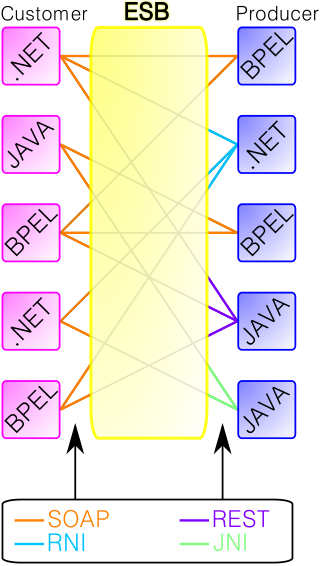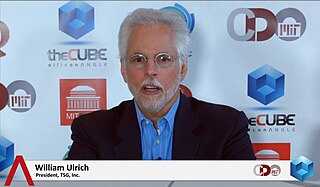Related Research Articles
The Common Object Request Broker Architecture (CORBA) is a standard defined by the Object Management Group (OMG) designed to facilitate the communication of systems that are deployed on diverse platforms. CORBA enables collaboration between systems on different operating systems, programming languages, and computing hardware. CORBA uses an object-oriented model although the systems that use the CORBA do not have to be object-oriented. CORBA is an example of the distributed object paradigm.
In software engineering, a design pattern describes a relatively small, well-defined aspect of a computer program in terms of how to write the code.
In software engineering, service-oriented architecture (SOA) is an architectural style that focuses on discrete services instead of a monolithic design. SOA is a good choice for system integration. By consequence, it is also applied in the field of software design where services are provided to the other components by application components, through a communication protocol over a network. A service is a discrete unit of functionality that can be accessed remotely and acted upon and updated independently, such as retrieving a credit card statement online. SOA is also intended to be independent of vendors, products and technologies.

An enterprise service bus (ESB) implements a communication system between mutually interacting software applications in a service-oriented architecture (SOA). It represents a software architecture for distributed computing, and is a special variant of the more general client-server model, wherein any application may behave as server or client. ESB promotes agility and flexibility with regard to high-level protocol communication between applications. Its primary use is in enterprise application integration (EAI) of heterogeneous and complex service landscapes.
Enterprise architecture (EA) is a business function concerned with the structures and behaviours of a business, especially business roles and processes that create and use business data. The international definition according to the Federation of Enterprise Architecture Professional Organizations is "a well-defined practice for conducting enterprise analysis, design, planning, and implementation, using a comprehensive approach at all times, for the successful development and execution of strategy. Enterprise architecture applies architecture principles and practices to guide organizations through the business, information, process, and technology changes necessary to execute their strategies. These practices utilize the various aspects of an enterprise to identify, motivate, and achieve these changes."
Service-orientation is a design paradigm for computer software in the form of services. The principles of service-oriented design stress the separation of concerns in the software. Applying service-orientation results in units of software partitioned into discrete, autonomous, and network-accessible units, each designed to solve an individual concern. These units qualify as services.

IONA Technologies was an Irish software company founded in 1991. It began as a campus company linked to Trinity College Dublin had its headquarters in Dublin, and eventually also expanded its offices in Boston and Tokyo. It specialised in distributed service-oriented architecture (SOA) technology, its products connecting systems and applications by creating a network of services without requiring a centralised server or creating an information technology project. IONA was the first Irish company to float on the NASDAQ exchange. It was valued at up to US$1.75 billion at its peak. It was one of the world's 10 largest software-only companies, and around 30 new ventures spun out from it. IONA was sold to Progress Software in 2008.

Kerrie Lamont Holley is an American software architect, author, researcher, consultant, and inventor. He recently joined Industry Solutions, Google Cloud. Previously he was with UnitedHealth Group / Optum, their first Technical Fellow, where he focused on ideating healthcare assets and solutions using IoT, AI, graph database and more. His main focus centered on advancing AI in healthcare with an emphasis on deep learning and natural language processing. Holley is a retired IBM Fellow. Holley served as vice president and CTO at Cisco responsible for their analytics and automation platform. Holley is known internationally for his innovative work in architecture and software engineering centered on the adoption of scalable services, next era computing, service-oriented architecture and APIs.
Service-oriented modeling is the discipline of modeling business and software systems, for the purpose of designing and specifying service-oriented business systems within a variety of architectural styles and paradigms, such as application architecture, service-oriented architecture, microservices, and cloud computing.
Service Component Architecture (SCA) is a software technology designed to provide a model for applications that follow service-oriented architecture principles. The technology, created by major software vendors, including IBM, Oracle Corporation and TIBCO Software, encompasses a wide range of technologies and as such is specified in independent specifications to maintain programming language and application environment neutrality. Many times it uses an enterprise service bus (ESB).
The first version of the Enterprise Collaboration Architecture (ECA) has been published by the Object Management Group (OMG) in 2001. The vision of the (ECA) is to simplify the development of component based and services oriented systems by providing a modeling framework aligned with the model-driven architecture (MDA) of the Object Management Group (OMG).
Richard Veryard FRSA is a British computer scientist, author and business consultant, known for his work on service-oriented architecture and the service-based business.
Paul Harmon is an American management consultant, author and analyst, known for his work in the field of Expert systems in the 1980s, and more recently on Business process management (BPM).
Oliver Sims was a British computer scientist, former IBM employee, and enterprise architecture consultant, known for his work on business objects Object-oriented programming, and service-oriented architecture (SOA).

Michael B.T. Bell is an American novelist, artist, producer, and enterprise software architect, chiefly recognized for developing the Incremental Software Architecture methodology, service-oriented modeling framework (SOMF), multidimensional software architecture construction (MSAC), and the cloud computing modeling notation (CCMN). His innovative research and publications in the fields of software architecture, artificial intelligence, service-oriented architecture, Microservices, model-driven engineering, cloud computing, and big data are recognized internationally for their contribution to the software design and development communities.

Sparx Systems Enterprise Architect is a visual modeling and design tool based on the OMG UML. The platform supports: the design and construction of software systems; modeling business processes; and modeling industry based domains. It is used by businesses and organizations to not only model the architecture of their systems, but to process the implementation of these models across the full application development life-cycle.

William M. Ulrich is an American business architecture consultant, consultant at Cutter Consortium, director and lecturer, known for development of 'The Systems Redevelopment Methodology' (TSRM) in the 1990s, on legacy systems in the 2000s and more recently on his work on business architecture.
David S. Frankel is an American Information Technology expert and consultant, known for his work on model-driven engineering and semantic information modeling.
The Business Architecture Special Interest Group (BASIG) is a working group on business architecture of the Object Management Group (OMG), known for their contribution to the history of business architecture. This working group was founded in 2007 as the Business Architecture Working Group (BAWG).
Gennaro "Jerry" Cuomo is an American software engineer who has worked for IBM since 1987. Holding the title of IBM Fellow, Cuomo is known as one of the founding fathers of IBM WebSphere Software, a software framework and middleware that hosts Java-based web applications.
References
- ↑ Pritchard, Jason. COM and CORBA side by side: architectures, strategies, and implementations. Addison-Wesley Longman Publishing Co., Inc., 1999.
- ↑ Tai, Wolfgang Emmerich Stefan. Engineering distributed objects. (2000).
- ↑ Cândido, Gonçalo, et al. "SOA in reconfigurable supply chains: A research roadmap." Engineering applications of artificial intelligence 22.6 (2009): 939-949.